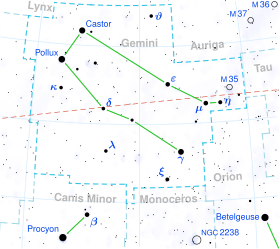Mu Geminorum
| Observation data Epoch J2000.0 Equinox J2000.0 (ICRS) |
|
|---|---|
| Constellation | Gemini |
| Right ascension | 06h 22m 57.62686s |
| Declination | +22° 30′ 48.8979″ |
| Apparent magnitude (V) | 2.857 |
| Characteristics | |
| Spectral type | M3 III |
| B−V color index | +1.643 |
| Variable type | LB |
| Astrometry | |
| Radial velocity (Rv) | +54.38 ± 0.24 km/s |
| Proper motion (μ) |
RA: +56.39 mas/yr Dec.: –110.03 mas/yr |
| Parallax (π) | 14.08 ± 0.71mas |
| Distance | 230 ± 10 ly (71 ± 4 pc) |
| Details | |
| Mass | 2.1 M☉ |
| Luminosity | 2,799 L☉ |
| Surface gravity (log g) | 1.50 cgs |
| Temperature | 3,773 K |
| Rotational velocity (v sin i) | 8.4 km/s |
| Other designations | |
| Database references | |
| SIMBAD | data |
Mu Geminorum (μ Gem, μ Geminorum), also named Tejat, is a star in the northern constellation of Gemini.
μ Geminorum (Latinised to Mu Geminorum) is the system's Bayer designation.
It bore the traditional name Tejat, or Tejat Posterior, which means back foot, because it is the foot of Castor, one of the Gemini twins. The proper name Tejat Posterior was formerly applied to an asterism consisting of this star, along with γ Gem (Alhena), ν Gem, η Gem (Tejat Prior), and ξ Gem (Alzirr). The names Calx (Latin, meaning heel), Pish Pai (from the Persian Pīshpāy, پیشپای, meaning foreleg), and Nuhatai (from Arabic Al Nuḥātai, the dual form of Al Nuḥāt, "a Camel's Hump") have also been applied to Mu Geminorum. In 2016, the International Astronomical Union organized a Working Group on Star Names (WGSN) to catalogue and standardize proper names for stars. The WGSN approved the name Tejat for this star on February 1st 2017 and it is now so entered in the IAU Catalog of Star Names.
In Chinese, 井宿 (Jǐng Su), meaning Well (asterism), refers to an asterism consisting of μ Geminorum, γ Geminorum, ν Geminorum, ξ Geminorum, ε Geminorum, 36 Geminorum, ζ Geminorum and λ Geminorum. Consequently, μ Geminorum itself is known as 井宿一 (Jǐng Su yī, English: the First Star of Well.)
...
Wikipedia

